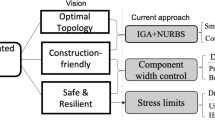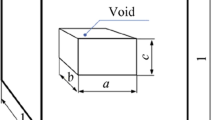Abstract
Design optimization of beam structures is a significant topic as beams are an efficient load-carrying component in engineering applications. Most of the earlier researches concentrate on the structural optimization of beams with invariant cross-section topology, and design optimization of periodic beam structures, which cross-section topology varies along the axial direction, has not been extensively investigated. This work presents a novel approach based on the relaxed Saint-Venant solution to conduct microstructural topology optimization of periodic beam structures for minimum structural compliance. One benefit of adopting Saint-Venant solution based compliance formulation is that the strain energy induced by transverse shear loading is incorporated in the structural compliance, which is not reflected in that based on first-order homogenization of the asymptotic homogenization (AH) theory, so that a more reasonable objective function is adopted for the optimization problem. In addition, a material connectivity constraint, which is constructed by restraining the ratio of the strain energy calculated from relaxed Saint-Venant solution to that obtained from first-order homogenization of the AH theory, is further proposed to prevent material separation or to strengthen material connection through the thickness direction. The detailed sensitivity analysis of the objective function and the constraints are carried out with the adjoint method, and several numerical examples are given to show the validity of the relaxed Saint-Venant solution based compliance formulation and the effectiveness of the proposed material connectivity constraint.














Similar content being viewed by others
References
Andreassen E, Clausen A, Schevenels M, Lazarov BS, Sigmund O (2011) Efficient topology optimization in MATLAB using 88 lines of code. Struct Multidiscip Optim 43(1):1–16
Bendsøe MP, Kikuchi N (1988) Generating optimal topologies in structural design using a homogenization method. Comput Methods Appl Mech Eng 71(2):197–224
Berdichevsky VL, Armanios E, Badir A (1992) Theory of anisotropic thin-walled closed-cross-section beams. Compos Eng 2(5–7):411–432
Blasques JP, Stolpe M (2012) Multi-material topology optimization of laminated composite beam cross sections. Compos Struct 94(11):3278–3289
Buannic N, Cartraud P (2001a) Higher-order effective modeling of periodic heterogeneous beams. I Asymptotic expansion method. Int J Solids Struct 38(40–41):7139–7161
Buannic N, Cartraud P (2001b) Higher-order effective modeling of periodic heterogeneous beams. II Derivation of the proper boundary conditions for the interior asymptotic solution. Int J Solids Struct 38(40–41):7163–7180
Collet M, Noel L, Bruggi M, Duysinx P (2018) Topology optimization for microstructural design under stress constraints. Struct Multidiscip Optim 58(6):2677–2695
De Miguel AG, Pagani A, Yu W, Carrera E (2017) Micromechanics of periodically heterogeneous materials using higher-order beam theories and the mechanics of structure genome. Compos Struct 180:484–496
Dong SB, Kosmatka JB, Lin HC (2001) On Saint–Venant’s problem for an inhomogeneous, anisotropic cylinder - part I: methodology for Saint–Venant solutions. J Appl Mech-T ASME 68(3):376–381
Donoso A, Sigmund O (2004) Topology optimization of multiple physics problems modelled by Poisson’s equation. Latin Am J Solids Struct 1(2):169–184
Geymonat G, Krasucki F, Marigo JJ (1987) Sur la commutativité des passages à la limite en théorie asymptotique des poutres composites. Comptes Rendus de l’Académie des Sciences, Série II 305:225–228
Giavotto V, Borri M, Mantegazza P, Ghiringhelli G, Carmaschi V, Maffioli GC, Mussi F (1983) Anisotropic beam theory and applications. Comput Struct 16(1–4):403–413
Guest JK, Prévost JH (2006) Optimizing multifunctional materials: design of microstructures for maximized stiffness and fluid permeability. Int J Solids Struct 43(22–23):7028–7047
Hassani B, Hinton E (1998) A review of homogenization and topology optimization I—homogenization theory for media with periodic structure. Comput Struct 69(6):707–717
Ieşan D (1976) Saint-Venant’s problem for inhomogeneous and anisotropic elastic bodies. J Elast 6(3):277–294
Kim YY, Kim TS (2000) Topology optimization of beam cross sections. Int J Solids Struct 37(3):477–493
Kim JS, Wang KW (2010) Vibration analysis of composite beams with end effects via the formal asymptotic method. J Vib Acoust 132(4):041003
Kim JS, Cho M, Smith EC (2008) An asymptotic analysis of composite beams with kinematically corrected end effects. Int J Solids Struct 45(7–8):1954–1977
Kolpakov AG (1991) Calculation of the characteristics of thin elastic rods with a periodic structure. PMM-J Appl Math Mec 55(3):358–365
Kolpakov AG (2004) Stressed composite structures: homogenized models for thin-walled nonhomogeneous structures with initial stresses. Springer Science & Business Media, Heidelberg
Lazarov BS, Sigmund O (2011) Filters in topology optimization based on Helmholtz-type differential equations. Int J Numer Methods Eng 86(6):765–781
Liu S, An X, Jia H (2008) Topology optimization of beam cross-section considering warping deformation. Struct Multidiscip Optim 35(5):403–411
Liu J, Li QH, Liu ST, Tong LY (2018) Dynamic topology optimization design of rotating beam cross-section with gyroscopic effects. Struct Multidiscip Optim 58(4):1467–1487
Liu J, Li QH, Liu ST, Tong LY (2019) Concurrent optimization design of axial shape and cross-sectional topology for beam structures. Struct Multidiscip Optim 59(6):2287–2302
Nguyen HD, Jang GW, Kim DM, Kim YY (2018) Finite prism method based topology optimization of beam cross section for buckling load maximization. Struct Multidiscip Optim 57(1):55–70
Papanicolau G, Bensoussan A, Lions JL (1978) Asymptotic analysis for periodic structures. North Holland Publ, Amsterdam
Rouf K, Liu X, Yu WB (2018) Multiscale structural analysis of textile composites using mechanics of structure genome. Int J Solids Struct 136:89–102
Saint-Venant BD (1855) Memoire sur la torsion des prismes. Mem Savants Etrangers 14:233–560
Sigmund O (1994) Design of material structures using topology optimization. PhD thesis, Department of Solid Mechanics, Technical University of Denmark
Sigmund O (2007) Morphology-based black and white filters for topology optimization. Struct Multidiscip Optim 33(4–5):401–424
Svanberg K (1987) The method of moving asymptotes—a new method for structural optimization. Int J Numer Methods Eng 24(2):359–373
Volovoi VV, Hodges DH, Berdichevsky VL, Sutyrin VG (1999) Asymptotic theory for static behavior of elastic anisotropic I-beams. Int J Solids Struct 36(7):1017–1043
Wang F (2018) Systematic design of 3D auxetic lattice materials with programmable Poisson’s ratio for finite strains. J Mech Phys Solids 114:303–318
Wang F, Lazarov BS, Sigmund O (2011) On projection methods, convergence and robust formulations in topology optimization. Struct Multidiscip Optim 43(6):767–784
Xu L, Cheng G (2019) On the solutions to the Saint–Venant problem of heterogeneous beam-like structures with periodic microstructures. Int J Mech Sci 163:105123
Yi SN, Xu L, Cheng GD, Cai YW (2015) FEM formulation of homogenization method for effective properties of periodic heterogeneous beam and size effect of basic cell in thickness direction. Comput Struct 156:1–11
Yi SN, Cheng G, Xu L (2016) Stiffness design of heterogeneous periodic beam by topology optimization with integration of commercial software. Comput Struct 172:71–80
Yu WB, Blair M (2012) GEBT: a general-purpose nonlinear analysis tool for composite beams. Compos Struct 94(9):2677–2689
Yu WB, Hodges DH, Volovoi V, Cesnik CE (2002) On Timoshenko-like modeling of initially curved and twisted composite beams. Int J Solids Struct 39(19):5101–5121
Funding
This work is supported by National Natural Science Foundation of China (Grant No. 12002159), a Project Funded by the Priority Academic Program Development of Jiangsu Higher Education Institutions (PAPD), Natural Science Foundation of Liaoning Province (2019-ZD-0021), the State Key Laboratory of Mechanics and Control of Mechanical Structures at NUAA (no. MCMS-E-0520 K02), and the Key Laboratory of Impact and Safety Engineering, Ministry of Education at Ningbo University (no. CJ201904).
Author information
Authors and Affiliations
Corresponding author
Ethics declarations
Conflict of interest
The authors declare that they have no conflict of interest.
Replication of results
All the model and optimization parameters are provided in the numerical examples and detailed sensitivity derivation is described in Appendix. Detailed FE formulation of structural analysis is given and methods used to conduct filtering are available in the cited literature. The readers can replicate the results through the proposed method in this work.
Additional information
Responsible Editor: Seonho Cho
Publisher's note
Springer Nature remains neutral with regard to jurisdictional claims in published maps and institutional affiliations.
Appendices
Appendix 1 Sensitivity analysis of the strain energy e SV
In Appendix 1, we conduct sensitivity analysis of the strain energy eSV in (33) with the adjoint method. First, it is easy to deduce that
where x is the vector of design variables. Thus the sensitivity of e with respect to ith design variable xi can be written as:
We start with the first term at the right hand side of (64) by introducing the following Lagrangian \( {e}_{L_1} \) as:
where \( {{}^{\mathrm{n}}\boldsymbol{\uplambda}}_{\mathrm{m}}^1,{{}^{\mathrm{n}}\boldsymbol{\upmu}}_{\mathrm{m}}^p\left(p=1,2,3,4\right) \) are the master degrees of freedom of adjoint vectors nλ1, nμp(p = 1, 2, 3, 4), which satisfy the periodic boundary condition: \( {{}^{\mathrm{n}}\boldsymbol{\uplambda}}^1=\mathbf{T}{{}^{\mathrm{n}}\boldsymbol{\uplambda}}_{\mathrm{m}}^1,{{}^{\mathrm{n}}\boldsymbol{\upmu}}^p=\mathbf{T}{{}^{\mathrm{n}}\boldsymbol{\upmu}}_{\mathrm{m}}^p \). Conduct sensitivity analysis in (65), collate terms containing \( \frac{\partial {{}^{\mathrm{n}}\mathbf{V}}_{\mathrm{m}}^1}{\partial {x}_i},\frac{\partial {{}^{\mathrm{n}}\overset{\sim }{\mathbf{u}}}_{\mathrm{m}}^p}{\partial {x}_i}\left(p=1,2,3,4\right) \) and set them to zero. Then the term \( \frac{\partial e}{\partial {{}^{\mathrm{n}}\mathbf{V}}^1}\frac{\partial {{}^{\mathrm{n}}\boldsymbol{V}}^1}{\partial {x}_i} \) in (64) can be readily obtained as:

where the vectors nλ1, nμp(p = 1, 2, 3, 4) are determined by the following adjoint equations:
Similarly, the second term at the right hand side in (64) can be calculated as:

where the adjoint vectors nλ2, nνp(p = 1, 2, 3, 4) are determined by the following adjoint equations:
Examining the equations for nμp and nνp in (67) and (69), we define vectors nξα(α = 1, 2), whose FE formulations are as follows:
and vectors nμp and nνp can be accordingly expressed as:
Substitute (71) into (66) and (68), and collate relevant terms. The first two terms in (64) can be rearranged as:
where \( {}^{\mathrm{n}}\overset{\sim }{\mathbf{V}}={\mathbf{T}}_2\left({}^{\mathrm{n}}\mathbf{U}+l{}^{\mathrm{n}}\overset{\sim }{\mathbf{u}}\right) \).
Next we tackle the third term in (64) and introduce the Lagrangian \( {e}_{L_2} \) as:
Following the same procedure, the sensitivity can be obtained as:
where vectors nηp(p = 1, 2, 3, 4) are determined from
Thus substitute (72) and (74), the sensitivity of strain energy eSV can be arranged as:
where the terms \( \frac{\partial e}{\partial {x}_i},\frac{\partial e}{\partial^{\mathrm{n}}{V}^{\alpha }}\left(\alpha =1,2\right),\frac{\partial e}{\partial {{}^{\mathrm{n}}\overset{\sim }{u}}^p}\left(p=1,2,3,4\right) \) can be readily obtained as:

where \( {\mathbf{F}}^{\mathrm{ext}}={\mathbf{F}}^{\mathrm{EBT}}+\frac{l}{2}\mathbf{Q} \), and the sensitivity of the effective compliance matrix C can be readily obtained from that of the effective stiffness matrix D as:

The sensitivity of the strain energy eAH in (39) can be then obtained as
Appendix 2 Analytical strain energy formulation for the I-section base cell
We first derive the closed-form strain energy formulation \( {e}_{\mathrm{analytical}}^{\mathrm{SV}2} \) in (44) of the I-section base cell subject to the transverse shear force and the bending moment in Fig. 4(a). As the thickness of the flange and the web is assumed much smaller than the dimensions of the cross-section, where the mechanics of thin walled structures can be applied, the normal stress σ33, which admits linear distribution along x2 direction, and the shear flow q in Fig. 15(b), which admits linear and quadratic distribution on the flange and the web respectively, can be readily calculated through mechanics of thin-walled structures. The stress components on different parts of the I-section in Fig. 15(c) are given by:
where \( {I}_1=\frac{t_2{h}^3}{12}+\frac{h^2{bt}_1}{2} \) is the moment of inertia around x1 axis. Then the strain energy can be analytically calculated as:
For the I-section subject to bending moment \( {\left.{M}_1\right|}_{\omega^{-}}=\frac{l}{2},{\left.{M}_1\right|}_{\omega^{+}}=-\frac{l}{2} \), which is adopted to calculate analytical eAH, the normal stress σ33 is readily calculated as:
and the strain energy can be derived as:
Rights and permissions
About this article
Cite this article
Xu, L., Qian, Z. Microstructural topology optimization of periodic beam structures based on the relaxed Saint-Venant solution. Struct Multidisc Optim 63, 1813–1837 (2021). https://doi.org/10.1007/s00158-020-02778-y
Received:
Revised:
Accepted:
Published:
Issue Date:
DOI: https://doi.org/10.1007/s00158-020-02778-y





